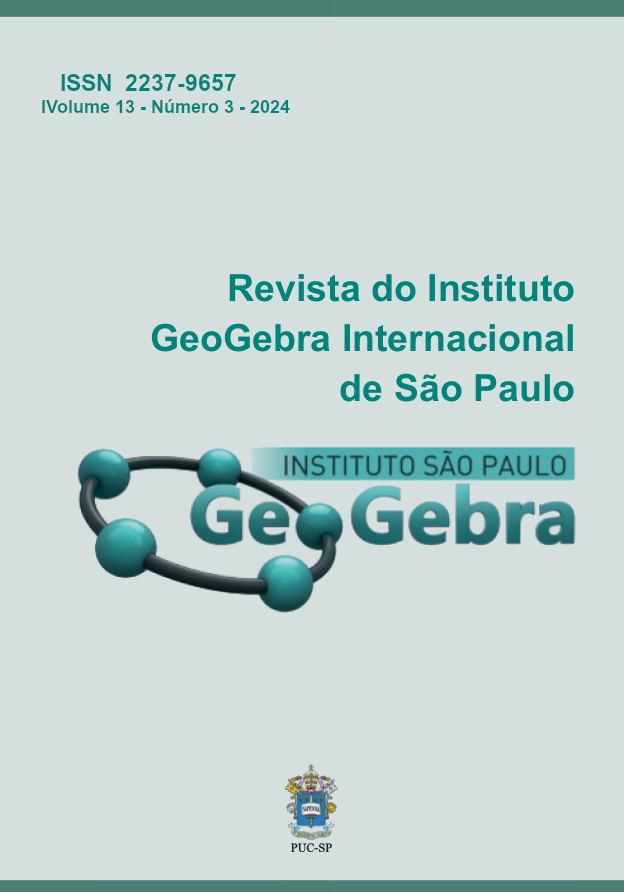The Rubik’s cube and GeoGebra: a visual exploration of permutation groups
DOI:
https://doi.org/10.23925/2237-9657.2024.v13i3p027-044Keywords:
Rubik's cube, Group Theory, Permutation Groups, GeoGebraAbstract
This article aims to use the construction of the Rubik’s Cube in GeoGebra as a primary tool for visualization and manipulation in the teaching of permutation groups in Abstract Algebra. We bring a brief discussion about the concept of group, aspects of the Rubik's cube, the Rubik’s group as a group of permutations and possibilities for its exploration in GeoGebra. Based on this study, we recognize the potential to delve into permutation groups in Abstract Algebra through a visual interface that associates their properties with a tangible and manipulable object. Additionally, there is the potential for simulating their movements using Dynamic Geometry software, such as GeoGebra.
References
Bandelow, C. (1982). Inside Rubik’s cube and beyond. Birkhäuser Boston.
Carter, N. C. (2009). Visual Group Theory. Bentley University.
Chen, J. (2004). Group Theory and the Rubik’s Cube. (Lecture notes). Texas State Honors Summer Math Camp.
Davvaz, B. (2021). Groups and Symmetry: theory and applications. Springer. https://doi.org/10.1007/978-981-16-6108-2
Garcia, A., & Lequain, Y. (2002). Elementos de Álgebra. Projeto Euclides. IMPA.
Gonçalves, A. (1995). Introdução à Álgebra. Projeto Euclides. IMPA.
Joyner, W. D. (1997). Mathematics of the Rubik’s cube. Faculty of Physics, University of Warsaw.
Joyner, W. D. (2008). Adventures in Grout Theory: Rubik’s Cube, Merlin’s Machine, and other Mathematical Toys. The Johns Hopkins University Press.
Travis, M. (2007). The Mathematics of the Rubik's Cube. University of Chicago.
Schültzer, W. (2005). Aprendendo Álgebra com o Cubo Mágico. V Semana da Matemática da UFU. UFSCar.
Sousa, R. T, Alves, F. R. V., & Aires, A. P. (2023). Categorias de Raciocínio Intuitivo no ensino de parábolas: Uma prática estruturada em Engenharia Didática. International Electronic Journal of Mathematics Education, 18 (4), em0746. https://doi.org/10.29333/iejme/13514
Sousa, R. T, Alves, F. R. V., & Aires, A. P. (2024). O GeoGebra no ensino de Álgebra Abstrata: uma abordagem dos grupos diedrais via Engenharia Didática. Ciência & Educação (Bauru), 30, e24030. https://doi.org/10.1590/1516-731320240030
Vágová, R., & Kmetová, M. (2018). The Role of Visualisation in Solid Geometry Problem Solving. Proceedings of 17th Conference on Applied Mathematics, Bratislava, pp. 1054-1064.
Warusfel, A. (1981). Réussir le Rubik’s cube. Éditions Denöel.
Wussing, H. (1984). The Genesis of the Abstract Group Concept. Dover Books on Mathematics.
Zazkis, R; Dubinsky, E., & Dautermann, J. (1996). Coordinating visual and analytic strategies: a study of students’ understanding of the Group D4. Journal for Research in Mathematics Education, 27(4), 435-457. https://www.jstor.org/stable/749876
Downloads
Published
How to Cite
Issue
Section
License
Copyright (c) 2024 Journal of the GeoGebra International Institute of São Paulo

This work is licensed under a Creative Commons Attribution 4.0 International License.
Submission, processing, and publication of articles sent to the journal and registration of the DOI at Crossref is free of charge.
Authors retain their copyright and grant the journal the right of first publication of their article, which is simultaneously licensed under a Creative Commons - Attribution 4.0 International license CC BY that allows others to share the article by acknowledging its authorship and initial publication by the journal.
The GeoGebra journal encourages its authors to register their work with information and communication management systems aimed at researchers, such as Academia.edu, Mendeley, ResearchGate, etc.


 10.23925
10.23925
